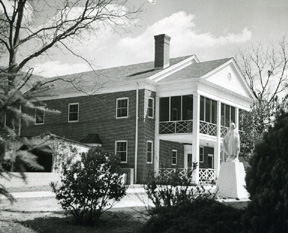St. Joseph School, New Bern, North Carolina

Published by: RoseDog Books
In 1926 Mother Casimir sent the first IHMs to St. Joseph's, New Bern, where a school had been established for "colored children" and conducted by lay people. They had made praiseworthy efforts, but no doubt because of their own meager knowledge of school management and instruction, the school was forcibly discontinued. It was the foresight and zeal of Reverend Charles Hannigan, SSJ, which resulted in the appointment of Sisters Lucinda Harrington, Sergius O'Donnell, and Marie Gabriel McQuade to teach the black children at St. Joseph's.
Twenty-three black children registered the first day, of whom only one was a Catholic. Gradually the enrollment increased until at the end of the first year there were ninety enrolled, and a convert class of about twenty.
Words reminiscent of Mother Teresa Maxis' early letters were used by one of the sisters to describe the first months of their life at St. Joseph's:
Early in November we moved into our little unfurnished convent. Its poverty was our joy. Our refectory table was a homemade 6 x 4 which had previously served the carpenters as a work table. We carried our chairs when needed from the classrooms to the Convent. (5)
Commenting on the visit of Reverend Bonaventure McHugh, CP, to their convent, it was said, "Noticing our lack of furniture, he offered to spend the money given him in charity to buy some furniture for our parlor so that we might at least ask our visitors to be seated when they called. The donation was thankfully received." (6)
But the furniture problem was not laid to rest until a friend of Father Sweeney's, Mr. John Stuart of the furniture firm of Stuart and Scanlon in Boston, was apprised of the sisters' needs and provided furnishings for their modest rooms.
The deprivations experienced were not all in the material order, as a further comment made clear. On Christmas morning Father Stephen Sweeney, CP, who was conducting missions at St. Joseph's arrived at the convent and said two Masses in the Chapel "bringing for the first time Our Lord to dwell with us in our Convent home."(7)
By the second year the sisters at St. Joseph's, New Bern, had expanded their work to include a catechetical school at St. Paul's Church, New Bern, and a class for black children in Washington, North Carolina, where Mother of Mercy School was later opened.
It was inevitable that the day would come when integration of black and white students would be a reality. The Supreme Court of the United States in the case of Brown vs. The Board of Education of Topeka declared racial segregation unconstitutional on May 31, 1955, thus "officially" prohibiting segregation. In 1962, this law was put into effect in the Raleigh Diocese by Bishop Vincent S. Waters, simultaneously merging St. Joseph's and St. Paul's, New Bern, and renaming St. Joseph's secondary school the "William Gaston Regional Catholic High School." This high school was to reach an enrollment of one hundred two students by the year of its closing in 1969. Its smallness had not interfered with its ability to offer high quality education and to merit its continued accreditation by the State of North Carolina. (8)
Reference:
5. Unsigned notes on "The Southern Missions," p. 4. Archives, IHM Generalate.
6. Ibid.
7. Ibid.
8. Annals of St. Joseph's, New Bern, NC. Archives, IHM Generalate.